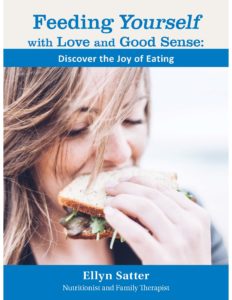

Family Meals Focus
The Ellyn Satter Institute Newsletter
Eating competence
by Ellyn Satter, Registered Dietitian and Family Therapist
The Satter Eating Competence Model (ecSatter) works, and so does the tool for testing it, the Satter Eating Competence Inventory (ecSI). People who score high on ecSI, who are eating competent, do better nutritionally, have the same or lower BMIs, 1 have higher HDLs and lower blood pressures, even when stress-tested, and have fewer of the components of ”sticky plaque,” today’s high-tech approach to predicting the tendency to cardiovascular disease.2 Remarkably, they are also healthier emotionally and socially. People with high eating competence feel more effective, are more self-aware and are more trusting and comfortable, both with themselves and with other people.1
ecSatter displaces the misery of prescriptive diets
For five years, Professor Barbara Lohse and I collaborated to examine ecSatter and validate ecSI. The validation paper published in the fall 2007 Journal of Nutrition Education and Behavior.1 ecSatter and ecSI are the result of my over 30 years’ experience clinical practice, where I found that I was making people miserable with my modified diets. Telling my patients what and how much to eat undermined their relaxed and positive relationship with food, destroyed their ability to trust themselves to eat as much as they needed, worsened their nutritional status, and spoiled their social engagements. They felt bad if they ate, and bad when they missed out on enjoyable food. Because eating is so central to life, my patients were not only demoralized about eating, they were demoralized in general. It was glaringly obvious that the harm far outweighed the benefit, so I changed my ways. Rather than trying to control or sidetrack my patients’ natural tendencies to regularly provide themselves with ample and enjoyable food, I learned to build on those tendencies by emphasizing permission and discipline:
- The permission to choose enjoyable food and eat it in satisfying amounts.
- The discipline to have regular and reliable meals and snacks and to pay attention when eating them.3
Being free and relaxed with eating seemed scary at first
Telling people to eat certain foods in certain amounts spoiled their eating and made them miserable.
Initially, my patients and I worried that such permission would send them out of control with their eating. In practice, being able to eat the foods they liked in satisfying amounts gave their eating order and stability. Foods that were no longer forbidden became ordinary foods that they could eat in ordinary ways. Large portion sizes become unappealing in the context of regular and reliable meals and snacks featuring adequate amounts of rewarding food. So-called “healthy foods” became appealing once they no longer had to eat them. As the years went on, I gradually organized my observations into a formal model and gave it a name: the Satter Eating Competence Model.4 My name is on the model to protect it, to keep others from giving it meanings different from what I intend. I also gradually wrote and clinically tested and retested a paper-and-pencil test to define attitudes and behaviors that make up healthy and positive eating. That became the 16 item ecSI – the Satter Eating Competence Inventory – that Dr. Lohse and I validated and tested.
ecSatter addresses eating attitudes and behavior, not food selection
There are four components for ecSatter:4
- Context: Take time to eat, and provide yourself with rewarding meals and snacks at regular and reliable times.
- Attitude: Cultivate positive attitudes about eating and about food. Emphasize providing rather than depriving; seeking food rather than avoiding it.
- Food acceptance: Enjoy your eating, eat foods you like, and let yourself be comfortable with and relaxed about what you eat. Enjoying eating supports the natural inclination to seek variety, the keystone of healthful food selection.
- Internal regulation: Pay attention to your sensations of hunger and fullness to determine how much to eat. Go to meals and snacks hungry, eat until you feel satisfied, and then stop, knowing another meal or snack is coming soon when you can do it again.
Use ecSatter instead of food restriction, not in addition to it
Dr. Lohse emphasizes that ecSatter represents a fundamental shift from the conventional approach to eating management. ”If it was successful to have people be uncomfortable and restrictive with what they eat, just going by the rules for the nutrients and calories they need, we would not have an obesity problem. We need a different mindset: Weight is not the big issue, but rather being comfortable with how you eat,” she emphasizes. Because it supports positive nutritional status, weight management and disease prevention,1,2 ecSatter provides an alternative approach to achieving the Dietary Guidelines. It is to be used instead of, not in addition to prescriptive approaches to food management such as MyPlate or DASH (Dietary Approaches to Stop Hypertension).
References
1. Lohse B, Satter E, Horacek T, Gebreselassie T, Oakland MJ. Measuring Eating Competence: Psychometric properties and validity of the ecSatter Inventory. J Nutr Educ Behav Suppl. 2007;39:S154-S166.
2. Psota T, Lohse B, West S. Associations between eating competence and cardiovascular disease biomarkers . J Nutr Educ Behav Suppl. 2007; 39:S171-S178.
3. Satter EM. Nutrition Education with the Satter Eating Competence Model. J Nutr Educ Behav Suppl. 2007;39:S189-S194.
4. Satter EM. Eating Competence: Definition and evidence for the Satter Eating Competence Model. J Nutr Educ Behav Suppl. 2007;39:S142-S153.
For more help with managing family meals, see Ellyn Satter’s Secrets of Feeding a Healthy Family.

